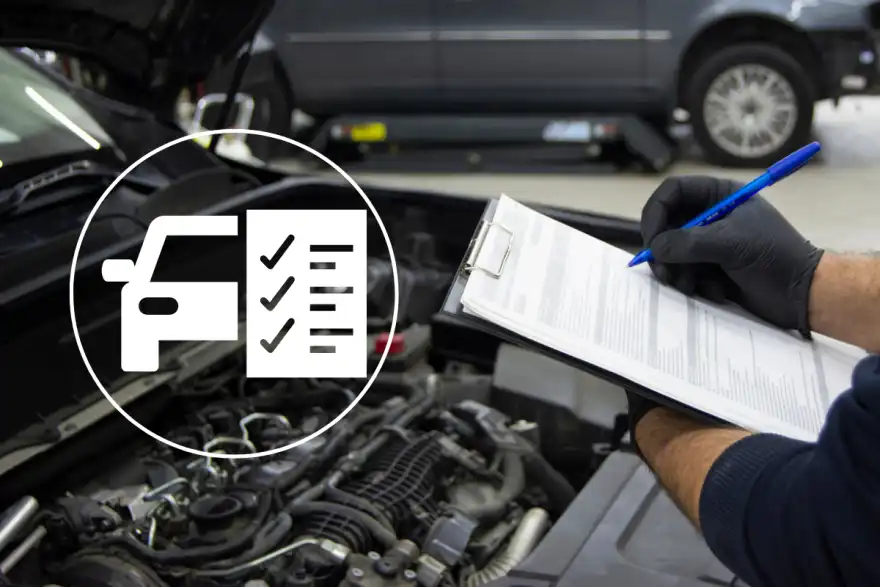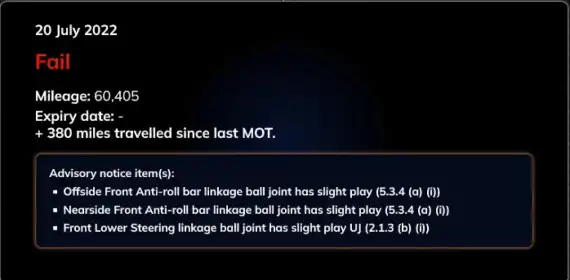
Thinking of buying a new car? Already own one and due for its MOT? In both cases, understanding a car's MOT history is crucial. This includes not just whether it passed or failed, but also any MOT advisories that were noted during the test.
What is an MOT Advisory?
An MOT advisory is a flag raised by the tester during an MOT test. It highlights areas of the car that aren't causing an immediate failure but may need attention in the near future to ensure roadworthiness and safety. These advisories can be anything from minor issues like a dimmed headlight bulb to more concerning problems like slight brake wear.
Why Check MOT Advisories?
MOT advisories offer valuable insight into the overall health of a car. By reviewing them, you can:
- Get a better idea of potential repair costs: Knowing about upcoming maintenance needs allows you to budget accordingly.
- Identify potential safety hazards: While not causing immediate failure, some advisories can point to underlying issues that could become dangerous if left unaddressed.
- Gain leverage when negotiating a car purchase: A history of concerning advisories can be a bargaining chip when buying a used car.
How Can I Find a Car's MOT Advisories?
The good news is that checking a car's MOT history, including its advisories, is a quick and free process.
Simply enter your car's registration number into Regit's free, online MOT history checker and find about your car's history, including the reason for MOT fails and advisories.

What are the Categories of MOT Advisories?
The New MOT Advisory Categories (Since 2018)
To better understand the severity of advisories, a system was introduced in 2018 that categorises them into three levels:
- Dangerous: These faults pose a direct threat to safety and will cause your MOT to fail. The car must be repaired before driving again.
- Major: Major faults could compromise the vehicle's roadworthiness or emissions. While you can technically drive with them for now, repairs are necessary to pass the next MOT.
- Minor: Minor defects have minimal impact on safety but can potentially develop into bigger issues. These advisories highlight areas that might need attention in the near future, helping you stay proactive with car maintenance.
What are the Most Common MOT Advisories?
1. Tyre Tread and Health:
Tyres with insufficient tread depth compromise safety, especially in bad weather. Additionally, cracks or damage require immediate attention. Regularly checking your MOT history helps you stay on top of tyre health and avoid potential dangers.
2. Brake Pads Wearing Thin:
Over time, brake pads wear down, reducing their effectiveness. An MOT advisory might indicate they have limited life remaining (often estimated in miles). Worn pads affect braking distance, so addressing this promptly is crucial. The average lifespan is around 50,000 miles, but consult your MOT history for specific details.
3. Faulty or Dim Lights:
Headlights, taillights, and indicators all play a vital role in visibility. A blown bulb, dimming light, or electrical fault can lead to an advisory. Mechanics might also suggest replacing older lights to prevent them failing on the road. Remember, knowing how to check your lights can help avoid fines and ensure you're seen by other drivers.
4. Corrosion Concerns:
Don't panic if your MOT history mentions rust. While surface or scale rust isn't an immediate threat, it's important to monitor it. However, if the rust penetrates the car's body, it can spread to critical components.
5. General Wear and Tear:
Bumps, dents, and scratches are common occurrences. While not immediate safety hazards, extensive damage can lead to parts falling off or causing internal problems. An MOT advisory might flag such concerns, prompting you to get them addressed to maintain your car's roadworthiness.
Should You Buy A Car with Advisories?
The answer depends on the type of advisory and your comfort level with potential repairs. Here's a breakdown:
- Dangerous or Major Advisories: It's generally best to avoid such cars unless you're prepared to address the issues immediately. These can be significant safety hazards and incur repair costs.
- Minor Advisories: A car with minor advisories can be a good purchase, especially if the price reflects the needed attention. You can factor in potential repair costs during negotiations. Remember, a well-maintained car with a history of addressed advisories might be a safer option in the long run.
Tips for Buying a Car with MOT Advisories:
- Scrutinise the MOT History: A detailed MOT history check reveals past advisories and repairs, giving you a clearer picture of the car's health.
- Get a Mechanic's Opinion: Have a trusted mechanic assess the car, focusing on the mentioned advisories. This can provide valuable insight into the severity and repair costs.
- Negotiate the Price: If you decide to proceed, factor in potential repair costs when negotiating the car's price.
Can you drive a car with advisories?
Yes, you can legally drive a car with MOT advisories.
However, while it is not mandatory, it's wise to address any MOT advisories sooner rather than later. This not only ensures your car remains safe and roadworthy but can also prevent minor issues from escalating into expensive repairs down the line.
While legal to drive, there are important points to remember about MOT advisories:
- Safety First: Ignoring advisories can be risky. Minor issues can snowball into major problems, impacting your safety and potentially leading to breakdowns.
- Future MOT Tests: Unaddressed advisories can morph into fails during your next MOT, causing delays and extra costs.
- Proactive Maintenance: Taking care of minor issues early is often cheaper than dealing with extensive repairs later.
Making an Informed Decision
By keeping an eye on your MOT history and promptly addressing advisories, you can ensure a safe and smooth ride for yourself and your car. Remember, even though you can drive with advisories, prioritising maintenance is crucial for long-term safety and avoiding unnecessary expenses.




